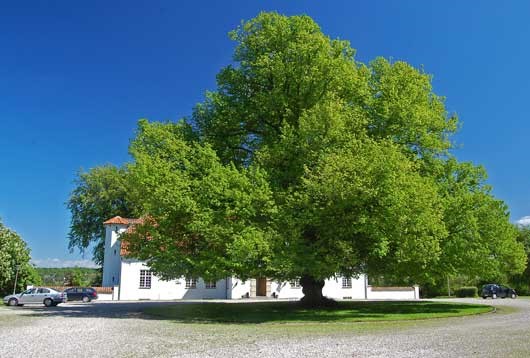Kavkaz jo'kasi

Tilia dasystyla is a deciduous tree, a species of the genus Tilia of the Malvaceae family. Tree up to 25 m tall, with dark, cracking bark on old trunks. Young shoots are dark brown and glabrous. The buds are oblong, glabrous, 4-5 mm long, 2-3 mm wide, dark brown. Petioles are thin, glabrous, 3-4 cm long. Leaves of fertile shoots are broadly ovate, 8-11 cm long, 6-8 cm wide, elongated to a point at the apex, truncated or slightly heart-shaped at the base, somewhat asymmetrical, serrated, triangular-shaped teeth, suddenly drawn out into a pointed point, dark green above, glabrous , shiny, light green below, glabrous, with beards of straight, simple yellowish hairs at the corners of the veins; basal veins number 6-8, veins of the second order number 5-8, veins of the third order are more or less straight, parallel to each other. Inflorescence equal in length to the bract, consisting of 3-5 flowers. The bract is oblong, more or less lanceolate-tapering, 7-9 cm long, 1.5-2 cm wide, very gradually descending downwards to the base of the peduncle (sessile) or slightly not reaching its base (on the petiole), on both sides completely naked, shiny on the side where the peduncle departs, and matte on the opposite side. The buds are round, about 3 mm in diameter, bare, dark brown. Sepals are lanceolate, 3-4 mm long, 1-2 mm wide, glabrous on the outside, covered with long white shiny hairs on the inside at the base, finely curly-haired along the edges; petals are spatulate, rounded at the upper end, with a slightly uneven edge, rapidly tapering downwards, 6-6.5 mm long, 1-1.5 mm wide; stamens 6-7 mm long; ovary round, loosely woolly pubescent; the style is woolly pubescent along its entire length, short, about 3 mm long; the stigma is bare, with five upward protruding or more or less splayed lobes. Blooms in June. The fruits are woody, woolly, pubescent, with five well-defined ribs. Fruits in July. It is found naturally in Crimea, Northern Iran, Northwestern Turkey, Azerbaijan, Georgia, Ciscaucasia and Dagestan.
Grows in oak forests. It is a relict species.
Subspecies Tilia dasystyla subsp. dasystyla grows only on Mount Kastel in Crimea and is included in the Red Book of Crimea.
In cultivation it is found in Batumi (1.5 m tall at 6 years old), in the city of Akhtala in Armenia (25 m tall at 15 years old) and in Tashkent.
Introduced to the Botanical Garden. The seeds of this species were brought from Kislovodsk and sown in the Botanical Garden by academician F.N. Rusanov in 1952. In 1952, in the spring, they were sown in a nursery and the introduction of these species was studied, also on 12.7.1959 they were planted in the European-Crimean-Caucasian exposition of the Tashkent Botanical Garden. Currently, there are 2 adult trees of this species growing in this exposition.




